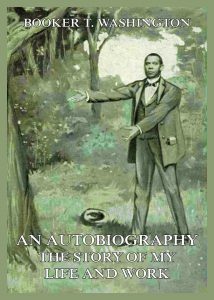An Autobiography: The Story of My Life and Work – Booker T. Washington
Mr. Washington, more than any other writer or lecturer, has solved the “race problem.” The historical value of the book, and its uplifting influence give ”The Story Of My Life And Work” a prominent place in modern literature. It is a volume for the family library along with the Life of Franklin, Emerson’s Essays and the great autobiographies. There is no greaterstimulus for self-help, for Mr. Washington forged his way to the front by his own efforts.
Format: Paperback.
An Autobiography: The Story of My Life and Work.
ISBN: 9783849674748.
Available at amazon.com and other venues.
Biography of Booker T. Washington (from Wikipedia):
Booker Taliaferro Washington (April 5, 1856 – November 14, 1915) was an American educator, author, orator, and advisor to presidents of the United States. Between 1890 and 1915, Washington was the dominant leader in the African-American community.
Washington was from the last generation of black American leaders born into slavery and became the leading voice of the former slaves and their descendants. They were newly oppressed in the South by disenfranchisement and the Jim Crow discriminatory laws enacted in the post-Reconstruction Southern states in the late 19th and early 20th centuries.
Washington was a key proponent of African-American businesses and one of the founders of the National Negro Business League. His base was the Tuskegee Institute, a historically black college in Alabama. As lynchings in the South reached a peak in 1895, Washington gave a speech, known as the “Atlanta compromise”, which brought him national fame. He called for black progress through education and entrepreneurship, rather than trying to challenge directly the Jim Crow segregation and the disenfranchisement of black voters in the South. Washington mobilized a nationwide coalition of middle-class blacks, church leaders, and white philanthropists and politicians, with a long-term goal of building the community’s economic strength and pride by a focus on self-help and schooling. But, secretly, he also supported court challenges to segregation and restrictions on voter registration, passing on funds to the NAACP for this purpose. Black militants in the North, led by W. E. B. Du Bois, at first supported the Atlanta compromise but after 1909, they set up the NAACP to work for political change. They tried with limited success to challenge Washington’s political machine for leadership in the black community but also built wider networks among white allies in the North.Decades after Washington’s death in 1915, the Civil Rights Movement of the 1950s took a more active and militant approach, which was also based on new grassroots organizations based in the South, such as CORE, SNCC and SCLC.
Booker T. Washington mastered the nuances of the political arena in the late 19th century, which enabled him to manipulate the media, raise money, develop strategy, network, push, reward friends, and distribute funds, while punishing those who opposed his plans for uplifting blacks. His long-term goal was to end the disenfranchisement of the vast majority of African Americans, who then still lived in the South.
(The text of the last section was taken from a Wikipedia entry and is available under the Creative Commons Attribution-ShareAlike License.)
Publisher’s Note: This book is printed and distributed by Createspace a DBA of On-Demand Publishing LLC and is typically not available anywhere else than in stores owned and operated by Amazon or Createspace.

